Neck Lift Surgery in Harley Street, London
One of the most frequent indicators of facial ageing are changes in the neck. The appearance of vertical bands in the neck and fullness below the jaw are common signs of facial ageing.
FACELIFT SURGERY IN HARLEY STREET
What is a Neck Lift?
Lifting of the neck restores the sharp angle between the jawline and neck associated with youth and removes the unsightly vertical bands in the neck.
Why Have a Neck Lift?
Ageing of the face is characterised by three key changes, loss of volume of the fat and soft tissues in the face, gravitational descent of facial soft tissues and laxity of the skin. For some patients, the majority of the changes are in their neck as a combination of facial ageing and often genetics.
A neck lift in London can improve your jawline, restore a youthful angle to your neck and remove loose skin and fullness. Many patients can result in a better neck than they had even in their thirties.
Key to natural-looking results is an artistic and anatomical understanding of these three elements, so the elements of facial ageing can be rejuvenated naturally.
With neck lift surgery, Dr De Silva’s philosophy is that there are three important aspects of facial surgery:
- Safety always comes first
- Best possible natural result and fast recovery
- A personalised journey where we support you during your recovery
Each of these aspects we have refined and improved to give you a smooth experience and recovery. A great looking neck lift requires a balance of respect to a patient’s genetic makeup surgical technical excellence and the surgeon’s artistic talent.
Dr De Silva has developed a signature neck lift that incorporates his artistry. Dr De Silva customises every neck lift to the patient’s facial characteristics and often will use complementary treatments to improve his patient’s results and enhance their recovery. Some patients can benefit from a smaller procedure limited to one-hour; other patients may need a combined facelift for the best result.
Why Choose Dr De Silva in Harley Street, London ?
Dr De Silva is a widely credited and celebrated facial plastic surgeon who specialises in the eyes, nose, face and neck areas only, and is known for natural results.
“My focus has and always will be to be the very best at what I do, to continually innovate to provide World Class leadership to all my team, all my patients and all my associates. My mission is to help every patient be the very best version of themself with World-Class services, life-long follow up with complimentary facial aesthetic procedures.”
In a world of increasing complexity and misinformation, his passion has been focused on providing sincere advice, low risk and fast recovery procedures.

Facelift & Facial Only Treatments
By focusing entirely on only facelift & facial cosmetic surgery procedures, Dr De Silva is able to provide the expertise that can only come with specialisation: facelift and neck lift, blepharoplasty, rhinoplasty and chin implants.
Natural Looking Results
Dr De Silva is a believer in the importance of artistry behind cosmetic results and focuses his skills at delivering natural looking results.
Fast Recovery
Dr De Silva has pioneered the advances in technology to speed up recovery with a combination regenerative medicine techniques, Oxygen and LED Therapy.
World Class Expertise
Dr De Silva also teaches other surgeons internationally and has contributed to the development of advanced surgical techniques, laser technology and stitch-less tissue adhesives.
Neck Lift Surgery Overview
Common Concerns with Neck Lift Surgery?
Many patients come to see Dr De Silva, as they are concerned about looking too different and want to have a natural rejuvenation with hidden scars and a fast recovery.
We have also seen media photographs of celebrities who look quite different from their youth and a natural-looking rejuvenation is important for most of my patients. Having a facelift or neck lift surgery is a “big” decision for many patients as it is a choice to undergo surgery.
Dr De Silva has respect for each person’s decision and provides a personalised evaluation and treatment options to enable you to make an informed decision about undergoing surgery.
This begins with a consultation to discuss the changes that you have noticed, the expectations you would like to see for improvement and a discussion regarding recovery and potential risks.
What Are the Different Types of Neck Lifts?
- Neck fat reduction
- Neck tightening stitches
- Neck muscle corset stitches (plastysmaplasty)
- Neck skin tightening (radiofrequency)
Combined facelift surgery
What Makes a Good Neck Or an Attractive Jawline?
We see a number of unnaturally pulled vectors or directions in the neck, so the vector or direction of elevation is very important.
Dr De Silva, a London neck lift specialist, places importance on establishing a smooth jawline as one of the most important aspects to an excellent result while avoiding the pulled tight look.
The vector of elevation should be parallel to the jawline in the front and at a slight angle towards the ear in the back to avoid puckering at the post-ear and achieve the most natural outcome.
The aim of the neck lift should be to get a distinct jawline along the mandibular bone, with a sharp angle to the neck.
The area may be filled with a layer of fat, which may be amenable to soft tissue reduction (including fat); alternatively, Dr De Silva will directly sculpt and stitch the soft tissue layer under direct visualisation.
Is there anything I can do to improve my double chin and flabby neck?
There are genetic factors that can result in excessive soft tissue (including fat) beneath the jawline and laxity in the platysma muscle that is not improved by weight loss, and this can result in a poorly shaped jawline and neck appearance at a relatively young age 20s-30s.
Weight loss will have an effect on improving the condition of your neck as there is fat that can accumulate under the neck.
However, with increasing age (over 40) there is reduced natural elasticity in the skin, and weight loss can result in loose skin below the neck. Loose skin cannot be effectively treated non-surgically and requires a surgical procedure to give a natural-looking rejuvenation.
Ageing changes in the neck including vertical bands in the neck, skin laxity and soft tissue changes below the jawline are not effectively treated with non-surgical methods and require neck lift surgery to give a natural-looking rejuvenation.
World Class Facial Cosmetic and Plastic Surgery
Neck Lift Before & Afters
Dr De Silva has transformed thousands of faces through his unique surgical techniques. Below is a small sample of some of his transformations.
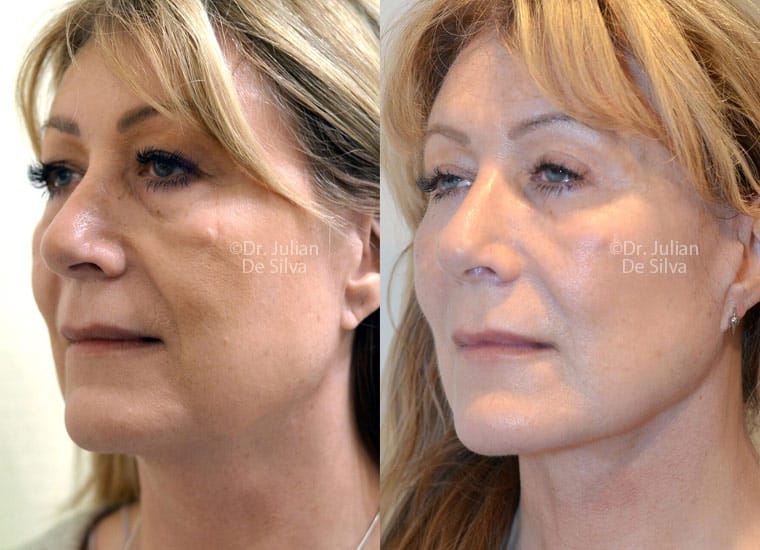
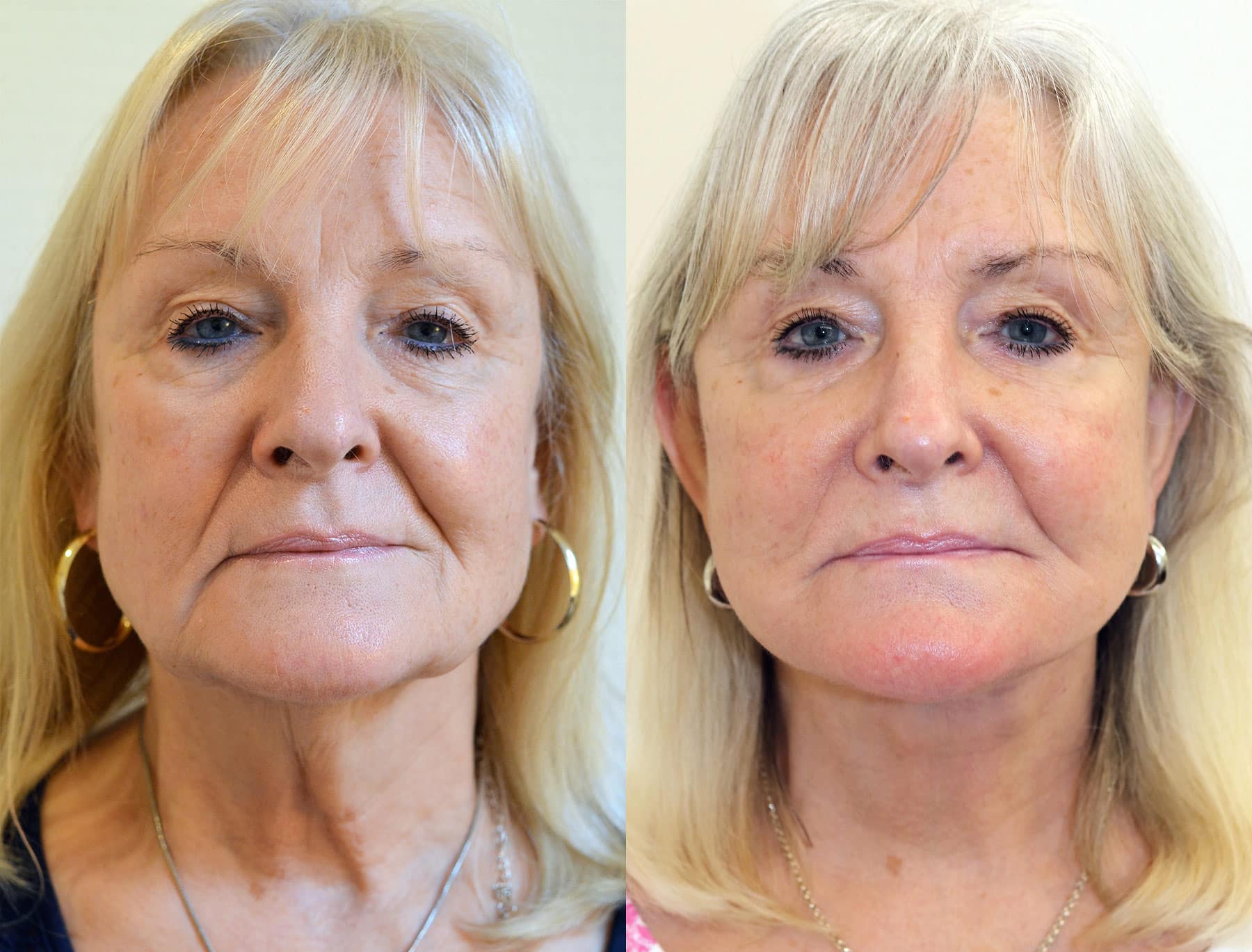
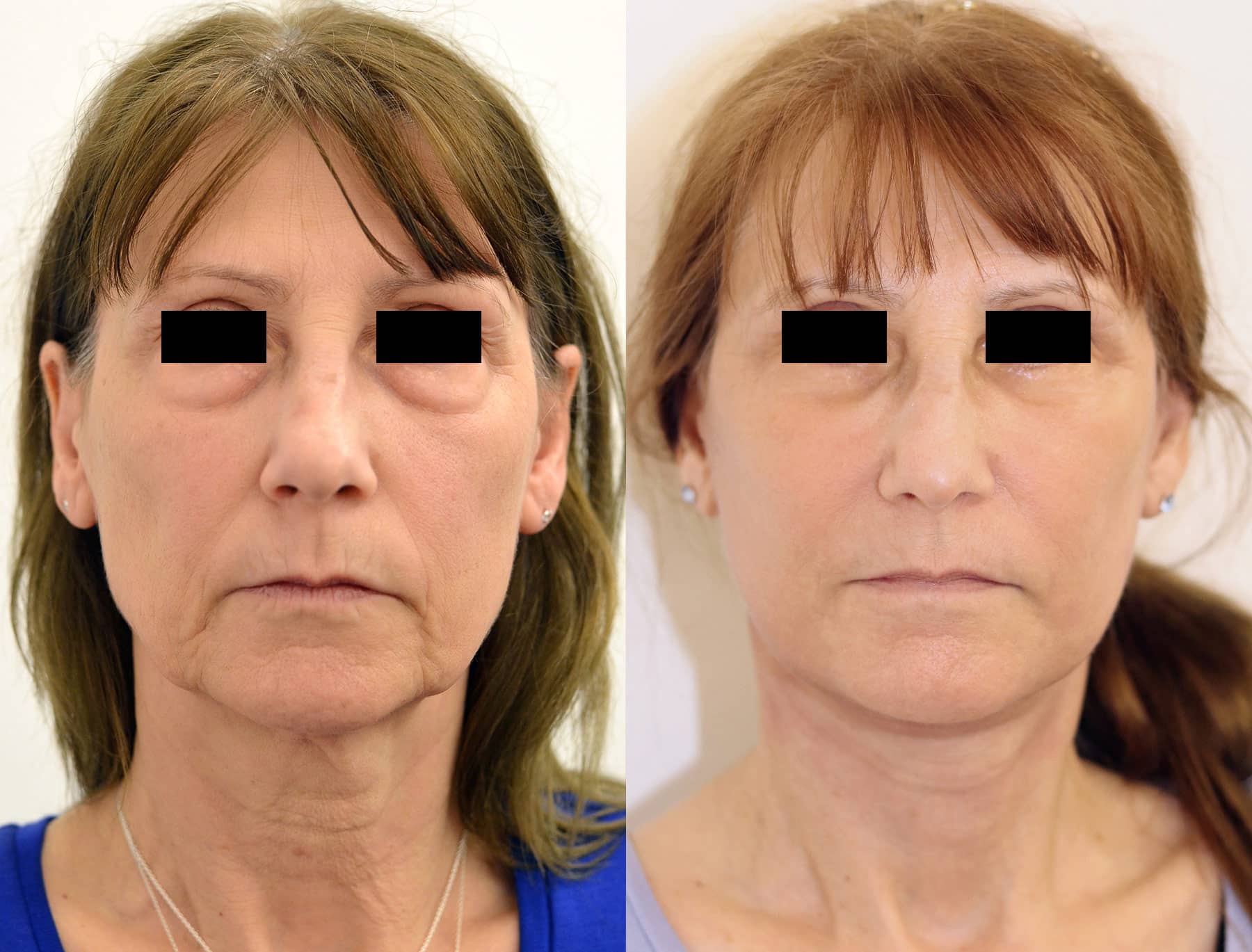
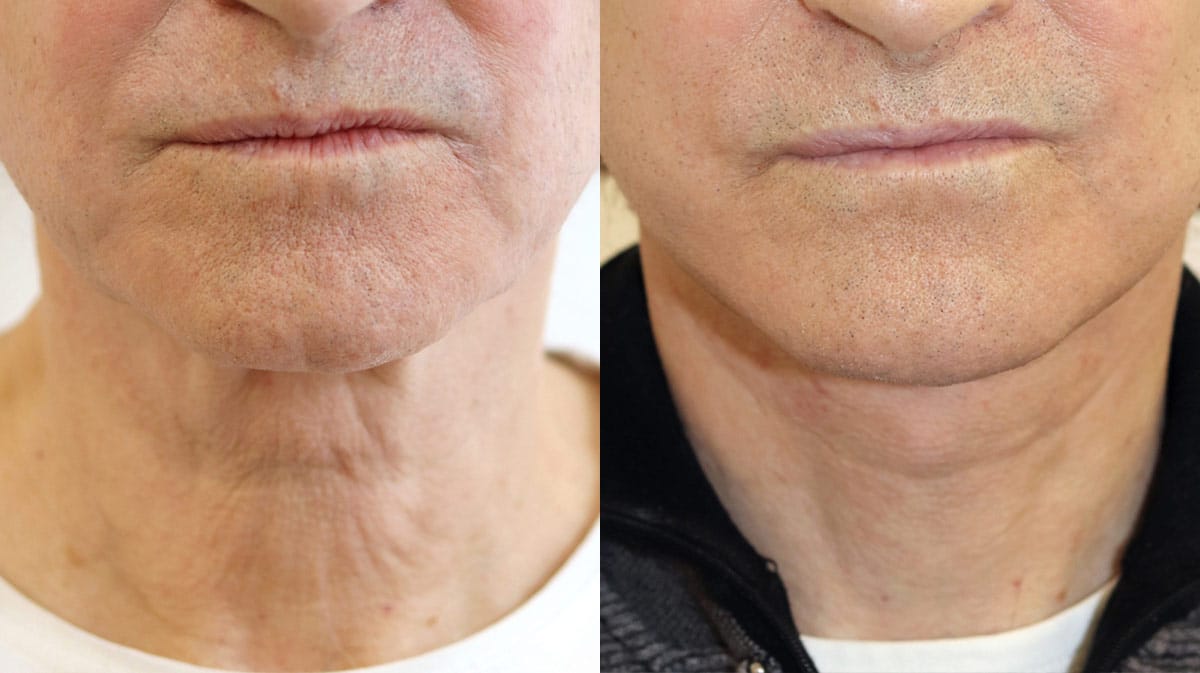
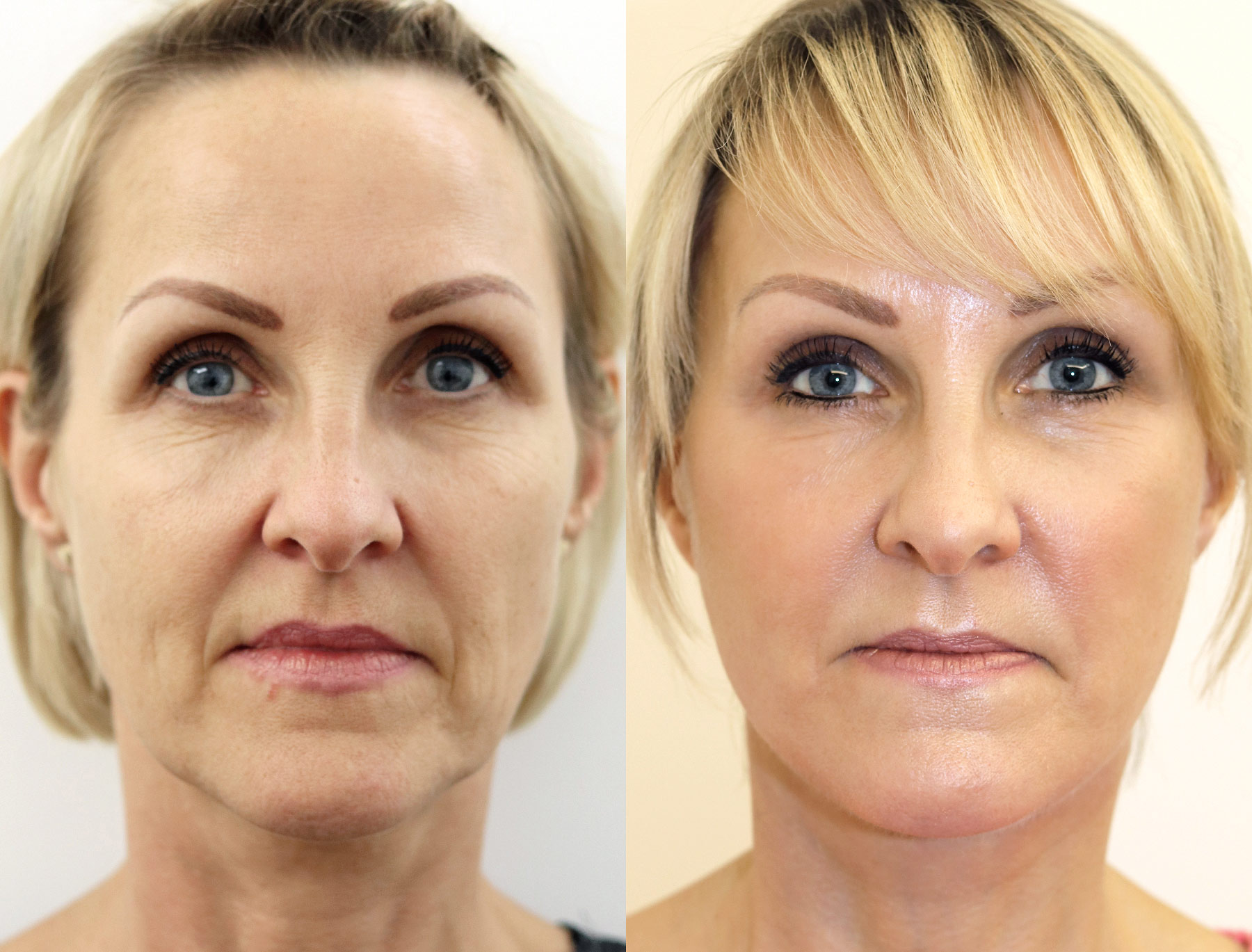
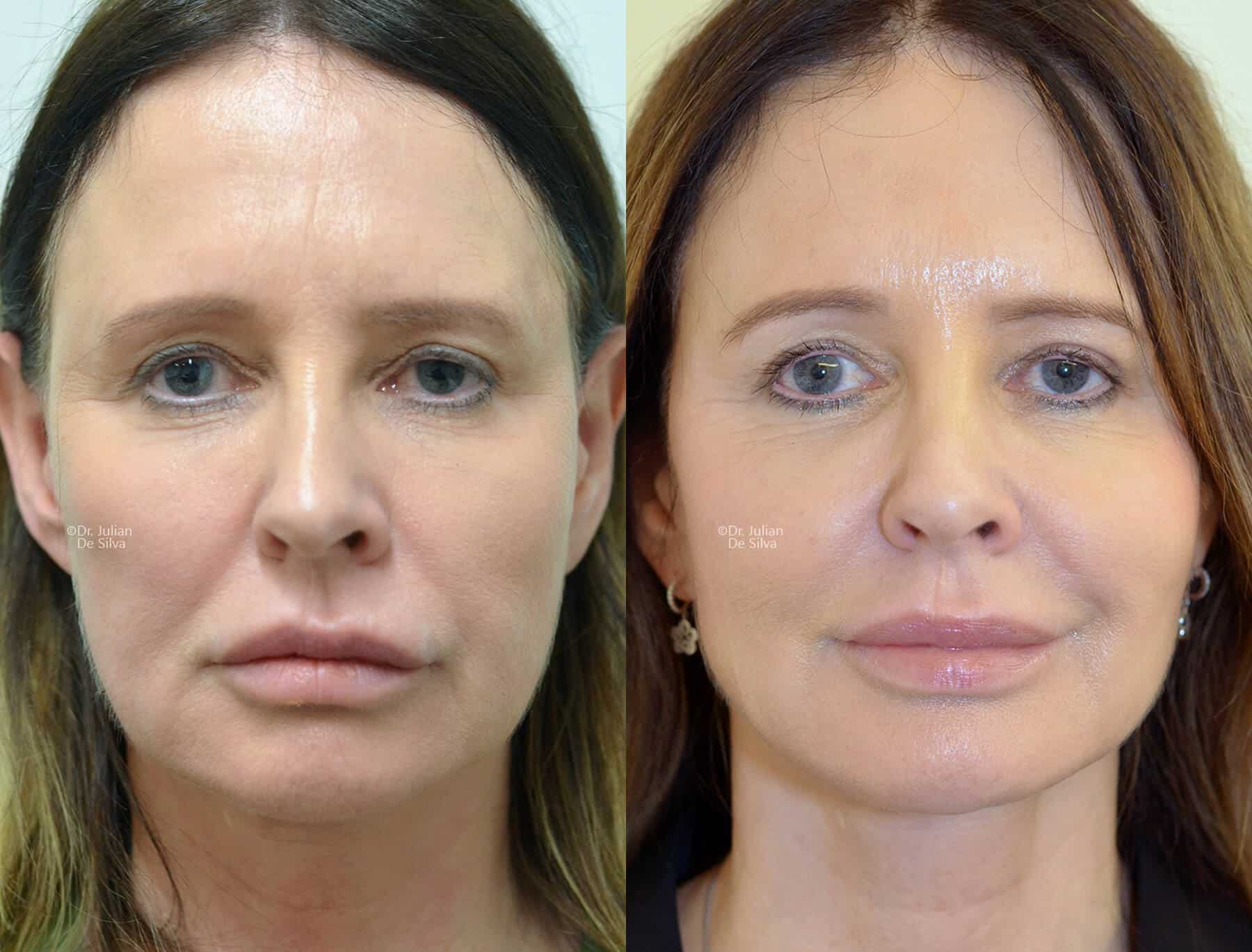
TESTIMONIAL
What our satisfied clients are saying
“I don’t normally write reviews but this one I had to do. I had a fairly significant procedure done with Dr De Silva recently. I am thrilled with the results and have been very impressed with the Practice throughout. Dr De Silva brings amazing skill and expertise to the surgery. Further I found him and all the staff fantastic to deal with; they were incredibly patient, kind, and went out of their way to make me feel at ease. I cannot remind Dr De Silva and team highly enough. I am very grateful and only wish I had done this sooner.”
Graeme
Neck Lift
Frequently Asked Questions
How long does a neck lift take?
The length of a neck lift will depend on the complexity of the surgery, the degree of laxity and facial ageing and patient ethnicity and sex.
On average a neck lift will take from 1 and a half to 3 hours, less than 90 minutes is a short length of time. There is a great deal of individual variation in the neck, and good surgery requires meticulous attention to detail, including measurements and time.
It is important that your surgeon takes adequate time to complete the surgery cautiously and without rushing. Combined face and neck lift takes on average 4 to 6 hours. Dr De Silva allows a minimum of 3-hours for most neck lift procedures and allows additional time to ensure the best possible result.
For more complex revision neck lifting and combination treatments including facelift, fat transfer and blepharoplasty additional time may be required up to 7-8 hours.
Dr De Silva generally limits neck lift to 4-hours as, after this time, there can be increased swelling that can affect the appearance of the neck.
What is facial ageing?
Facial ageing is characterised by the laxity of the skin, loss of facial volume and descent of soft tissues with gravity.
In the lower face, this results in a saggy appearance to the neck with loss of the natural neck angle and descent of soft tissue below the jaw that gives rise to the jowls.
Facial cosmetic surgery rejuvenates the soft tissue descent to its site above the jawline and tightens the lax skin.
Can other procedures be done at the same time as a facelift?
Volume deflation of the mid-face and cheeks are common signs of facial ageing and can be effectively treated with a filler or fat augmentation. Dr De Silva prefers the use of a natural filler to restore the face using a patients’ own soft tissues.
Dr De Silva often utilises fat transfer augmentation, as from our experience this gives a longer-lasting natural result. Fat transfer to faces that have had a substantial loss of volume can be very effective in restoring the malar mound and curvature of the cheeks giving a natural and youthful look.
Eye changes are a very common indicator of facial ageing and include drooping of the skin in the upper eyelid, dark circles and bulging pockets of fat in the upper and lower eyelids. These eyelid changes are commonly treated with blepharoplasty at the same time as a facelift in at least half of patients.
Ageing of the skin from damage by the sun and environmental elements results in lines and dark spots that may be effectively rejuvenated and smoothened with a combined facelift and laser resurfacing procedure. With the use of facelift and CO2 laser resurfacing of the skin, an excellent result can be obtained.
Dr De Silva takes precautions with the use of laser on the skin to ensure a high-quality result and may include skin area testing. Laser treatment of the face does result in some discomfort on day-1 after surgery; oral analgesia is adequate to relieve any discomfort.
After one week, the face has largely healed although a minority of people may have residual redness that can be covered with conformed.
Dr De Silva only uses the very latest in laser technology, as there is continued innovation in laser design, improving effectiveness and reducing downtime. Facial imbalance secondary to the underlying bone structure cannot be addressed by a facelift alone. Dr De Silva analyses the face as a whole, common shortcomings are in the chin and cheek areas; in some patients, these are addressed with volumetric addition with facial implants.
Dr De Silva prefers the use of silicone implants; these are very safe and have been used in the body for many decades and are undetectable once inserted. The nose undergoes ageing changes that include a drop of the tip of the nose with gravity and reduced bone support at the base of the nose resulting in rotation.
In cases where there are prominent ageing changes of the nose, Dr De Silva recommends a combine facelift and rhinoplasty procedure; this will restore the nose to a position and shape to suit a more youthful face.
In addition, irregularities such as a nasal hump can be sculpted and reshaped.
What are non-surgical facelifts? How effective are they?
Non-surgical techniques use a variety of volume fillers and tissue stitching while avoiding the opening of the tissues with surgery. These techniques do have an effect in rejuvenating the face by resorting to facial deflation.
Facial ageing is a combination of skin, soft tissues and underlying skeletal changes.
Although non-surgical lifts can aid some of the signs of facial ageing, they will only give a temporary effect. Patients that are prepared to have non-surgical facelift treatments should understand the effects are modest and will not be long-lasting.
To rejuvenate weathering of the skin, counteract facial descent, and skin laxity requires surgery. Dr De Silva provides advice and guidance on any of the latest cosmetic technological innovations; he only utilises techniques that give patients both natural-looking results and longevity.
Many new devices over the past 5-years have promised incredible results without surgery; often, they are heavily marketed and unproven. Most are only available for a short period of time, after which the devices are found to be less effective. Good advice is if something sounds too good to be true, it generally is.
For legal reasons, specific devices cannot be discussed on a public website.
Dr De Silva understands the difficult choices that patients have in deciding what to believe and will only use treatments that he knows are effective and appropriate for use on his family members and friends. Dr De Silva served as the clinical representative of the Ethics Committee at St. Mary’s Hospital from 2002-2006.
Facial ageing - what causes the changes?
Facial ageing is a combination of genetic and environmental factors. Particularly, sun exposure on the skin that causes dark spots, fine lines and wrinkling.
Our understanding of facial ageing has changed over the past 5-years. Prior to that, facial ageing was considered to be secondary to gravity and drooping of the face and neck.
The major leap in our understanding of facial ageing over the past few years has been the concept of fat compartments. They not only descend with gravity but also lose volume due to “deflation”.
Why does this matter?
Although isolated treatment of facial soft tissue droop or restoration of facial volume will have an effect, facial beauty is about symmetry, balance and harmony all of the multiple factors. What leads to a great natural-looking result is a simultaneous rejuvenation of the skin, soft tissues and underlying skeletal changes.
Volumetric fillers that have revolutionised the non-surgical approach to facial rejuvenation in the past few years will restore lost facial volume, soften deep facial lines and youthful appearance of the cheeks. However, in isolation, they can lead to the “over-filled” or “over-done” appearance that is characterised by some actors and actresses in the media.
The artistry in giving patients a natural result requires a harmonious approach that both restores volume and treatment of facial descent. Different faces will age in a unique manner; Dr De Silva tailors his treatment of every patient on an individual basis.
Some faces will require greater restoration of volume, and others will require greater rejuvenation of soft tissue descent.
Why have a facelift?
It will have the effect of rejuvenating the face, taking years off a persons’ appearance by restoring features of the face to a more youthful time.
Society places value on youth and beauty, through more successful jobs, more attractive partners and inner confidence and self-belief.
Although cosmetic surgery was once considered a premium luxury, it is now considered an investment in oneself, and an opportunity to revitalise and recapture a youthful external appearance that a person feels on the inside. Dr De Silva’s patients often describe feeling many years younger than they look.
A facelift is a way of lifting a patient’s self-esteem and restoring a balance between these factors.
Dr De Silva advises all his patients that successful rejuvenation of the face is about looking better – a complete absence of lines and wrinkles is not a desirable goal, as this looks fake. Dr De Silva considers success when friends comment on how great you look after surgery without knowing that you have had surgery, a natural rejuvenation.
Patients seeking a facelift are often looking for a more youthful appearance that can help with job prospects or in finding a partner, and the confidence that comes from a more youthful appearance.
Here are a few benefits of having a facelift:
– Dr De Silva utilises the most advanced treatments from the US.
– The surgery is completed the same day, allowing patients to go home on the day of surgery.
– There is no requirement to stay in hospital overnight, reducing the risk of infections.
In the UK, some hospitals still keep patients overnight, as hospital inpatient stays is the old way in which cosmetic surgery was practised. Patients usually take 1-2 weeks off work and social engagements, although after a couple of days, patients can do most non-strenuous activities.
Dr De Silva usually recommends the use of one of his overnight team to care for you over the first night. After 3-weeks, patients can return to all normal activities.
How do Dr De Silva's techniques differ?
Dr De Silva’s approach to surgery is based on two principles, a natural-looking result and the quickest recovery using the most modern and innovative techniques.
Dr De Silva utilises his own customised facelift technique that uses a double-layered deep-plane lifting that restores the youthful position of the face with respect to the natural lines and golden ratio.
This technique was developed from his experience from training in London Los Angeles and New York. Currently, he is publishing his technique as lead editor in a new multi-disciplinary book that includes international experts in facial cosmetic surgery.
A double-layered closure gives a more permanent lift designed to last many years and creates a natural look as it avoids tension on the skin, which is one of the hallmarks of surgery other single-layered techniques.
All faces change with time and at different speeds dependent on environmental and genetic factors. Dr De Silva’s technique uses a smaller incision that is hidden in the natural creases of the skin, behind the ear and in the hairline
Dr De Silva tailors the facelift to an individual’s patients facial ageing, underlying bone structure and soft tissue changes. In some patients’ faces, particularly men, restoration of the neck curvature is important, and Dr De Silva may use a double stitching imbrication technique to enhance the result.
Sometimes a natural look is about what not to do, in men over pulling off the soft tissues in the cheek does reduce lines in the face (e.g. nasolabial folds), however, can result in the feminisation of the male face.
Dr De Silva tailors his technique to the features of the face, and keeping a natural look is a combination of technique and artistry., Dr De Silva may suggest focusing entirely on a neck lift in some faces.
Dr De Silva’s approach to a face is an evaluation of symmetry, balance and proportion.
He completed his first facial surgery in 2002 at Imperial College London and has continued his passion for facial aesthetics over the past decade. He often utilises other techniques in combination with a facelift in order to give the most natural-looking result.
A combination of a facelift with laser skin rejuvenation has enhanced the results of many patients, by alleviating deep facial lines caused by exposure to the elements, principally the sun.
Dr De Silva often utilises fat grafting at the same time as facelift surgery. Fat grafting contains stem cells that have a rejuvenating effect on the soft tissues of the face. At the Anti-Ageing Medicine meeting in New York 2012, there was a great deal of excitement about the large potential of stem cells in cosmetic surgery and its benefits in enhancing rejuvenation.
The anatomy around the lower eyelids is complex; the eyelid is unique with an arrangement of bone vectors, muscle, natural fat compartments, fibrous tissue and a covering with the thinnest skin in the entire body.
Expertise is required in the rejuvenation of this area to avoid issues such as lumpiness and lid retraction. Dr De Silva has special expertise in this area and has treated numerous patients who have had non-specialized treatment in this area.
Dr De Silva advises patients seeking volume replacement with fat transfer to the face and eyelids to see surgeons specialising in the face to avoid problems.
Dr De Silva will hide the surgical incision, behind the ear and in the hairline that they are invisible months after surgery. In addition, every stage of the procedure has been meticulously enhanced to speed recovery and look natural.
The use of a modified deep plane facelift aids restoration of the natural facial contour of the cheek and lower face. Dr De Silva tailors the deep plane to the degree of facial ageing and soft tissue structures.
Dr De Silva has pioneered the development of techniques that enhance recovery.
These have included the use of regenerative medicine (growth factors and amniotic membrane products), use of scientifically proven oxygen and light therapy to speed up recovery. Although general anaesthesia is practised by some surgeons, Dr De Silva has developed sedation anaesthesia techniques that avoid the longer recovery, risks and hangover associated with general anaesthesia.
Dr De Silva trained in Los Angeles and New York, acquiring the most progressive and innovative experience from some of the best facial cosmetic surgeons in the world.
Dr De Silva may choose to use newer medications to reduce the likelihood of scar formation in patients with a history of scarring. These are applied as creams on the skin surface or administered through the skin to ensure even healing and the absence of scarring.
Dr De Silva teaches his skills and experiences in face and neck lift surgery, as director of an international facelift course, to other surgeons annually in the US. -ASOPRS
Will my friends and family know I have had a facelift?
The aim of surgery is to rejuvenate the face by restoring drooping soft tissues of the face (malar cheeks, jowls at the jawline), remove excess skin that has become lax, restore the youthful curvature of the neck and jaw-neck angle.
A good facelift is one that is natural-looking, by this avoids a fake wind-swept appearance that has been characterised by some cosmetic patients in the media.
Dr De Silva is known for creating a natural look, to do this, he uses specific techniques including a double-layered tightening, modified deep plane technique, hidden incisions and complementary techniques such as facial volume replacement.
“My objective is for friends and family to notice you looked freshened up and rejuvenated, however, do not know that you have undergone surgery.”
For the first couple of weeks after surgery, there will be a degree of bruising and swelling. For the first week, it is best to take things easy and generally keep a low profile. After one week, the residual bruising can be camouflaged with cosmetics, most patients will have some swelling, and can return to some more social activities if they like.
Dr De Silva generally recommends patients leave 1-2 weeks for recovery, and from 2-weeks patients can return to regular social activities.
What won't' a facelift do?
A facelift restores drooping of the soft tissues of the face and the sagging skin of the neck.
A facelift will not treat volume loss, termed deflation, in patients with volume loss, Dr De Silva advises volume replacement with fat augmentation or filler that will enhance the result. A facelift will not rejuvenate the skin, fine lines, dark spots and wrinkles. Dr De Silva will advise a combined technique to enhance the results.
Commonly a CO2 laser is used to resurface the skin, in some patients with darker skin tones, it is advisable to use an alternative skin resurfacing technique.
What kind of facelift leaves the smallest scars and the best results?
Scars from surgery are important to place to ensure they are discrete and difficult to see. Dr De Silva hides the scars in your natural hairline and natural curves of your ear. Dr De Silva spends meticulous time on each case to ensure the scars are hidden as far as possible, to close just one side of the fact takes 45-minutes with his technique, other techniques in front of the ear can be completed much faster, however, may result in visible scars.
Many surgeons use staples to save time in the hair; these can leave track scars and are very uncomfortable to remove. Dr De Silva only uses fine stitches in the face, which take additional time to insert; however, this avoids removing staples after surgery. Although no scars are invisible, most scars once healed are relatively discrete and difficult to see, only 1% of patients have issues with scars healing that may require additional treatment, e.g. keloid scarring.
A scar from surgery can include wide visible scars on the face, elongated pixie shaped ears as well as the loss of hairs or stepped patterns in the hairline, these results are avoidable by using specialised surgical techniques and meticulous attention to detail.
Contact Details
Call: 020 8748 2860
Email: info@drjuliandesilva.co.uk
Address:
23 Harley Street
London, W1G 9QN, UK
Dr Julian De Silva
5 stars based on 458 reviews

Renowned expert in Facelift/Facial Cosmetic and Plastic Surgery. Signature techniques in Blepharoplasty, Rhinoplasty and Facelift surgery. Expert in revision surgery and in natural looking results

